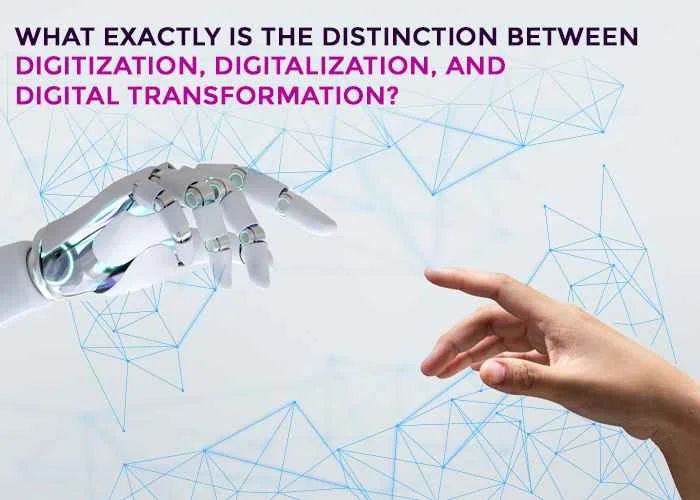What exactly is the distinction between digitization, digitalization, and digital transformation?

File analytics is one of the most effective methods for accessing the insights hidden inside an organization's unstructured data in today's data-driven environment (emails, MS Office, CAD, and other formats). Businesses, on the other hand, have two alternatives when it comes to examining any complicated paperwork. They can rely on manual indexing, in which personnel re-key and re-file data from each and every document, or they can use Optical Character Recognition (OCR) software to produce completely text-searchable documents ready for sorting and analysis. However, when millions of documents are at risk in the Energy, Financial Services, Life Sciences, and Insurance industries, manual indexing is neither possible nor cost-effective – much alone highly accurate. As a result, an automated OCR solution is a critical component of a file analytics solution, guaranteeing that important insights inside complicated documents can be found and used for business intelligence.
1. How Data Is Transformed by File Analytics.
While more businesses prioritize data collecting, not all of the data they collect is accessible or valuable for analytics. Only around 25% of business data is structured, which means it exists in text-based, machine-ready formats and can be readily identified and exploited. The converse is true for the remaining 75%, which is trapped in emails, TIFF files, photos, scanned documents, and other unstructured formats that cannot be easily exploited for market trends, changes in consumer behavior, or emerging hazards analysis and decision-making.
Businesses may use file analytics to turn their unstructured data warehouses into high-quality structured content by automatically crawling a wide range of documents and accompanying metadata to sort, analyze, and categorize it so that useful insights can be retrieved. This is especially important in situations where organizations must efficiently and accurately classify massive amounts of data, whether to meet compliance reporting requirements, such as those faced by oil and gas companies, or as part of a data migration during a merger or acquisition, product or asset swap, or system upgrade.
2. File Analytics is Powered by OCR Software.
In the same way that you can't expect to win at poker if you only see half of the cards in your hand, making informed business decisions need access to comprehensive data sets. That is why optical character recognition (OCR) is such an important component of file analytics, allowing organizations to correctly extract inaccessible data from documents by producing completely searchable text-based documents for analysis.
When a company has hundreds of terabytes of data, the potential insights inside these massive content vaults are huge. However, manually processing and categorizing every scanned, paper, and image-based file is just not practicable, posing a barrier to gaining any relevant business insights from their content. Businesses may use OCR software to automatically standardize image-based documents into searchable, accessible data that can subsequently be crawled for analysis. Furthermore, the superiority of automated OCR methods over manual indexing decreases the staff resources, expenses, and human error involved with manual data gathering.
3. File Analytics Requires Accurate OCR
The amount of OCR accuracy used by organizations as part of the file analytics process has a substantial influence on results. For example, if an OCR software solution does not support the languages in your documents or regularly inserts random characters into your translated text, these restrictions will have a knock-on effect on your capacity to do high-quality file analytics.
To begin, it is critical to compare the capabilities of your OCR software against your company's requirements. Some things to keep an eye out for are:
Consider the data-intensive research methods that a Life Sciences business must conduct in order to create life-saving pharmaceuticals. To use file analytics to get insights from their vast data vaults of chemicals and molecular designs, optical character recognition (OCR) must be used to guarantee that the information in each document is accurately recorded. When the objective is to enhance patient outcomes, the research data that supports the development of each medicine must be free of mistakes and omissions produced by low-quality data capture methods. As a result, OCR accuracy, as well as the speed and scalability of your system to manage increasing data quantities, are critical.
4. The Advantages of OCR Software in File Analytics
The combined strength of OCR software and file analytics alters a company's capacity to:
- Increase innovation by having access to and leveraging bigger volumes of data (including historical material) for high-quality insights.
- Identify danger by locating PII sources that were previously hidden and dormant in scanned paper documents or image-based files.
- Ensure that material is easily accessible to feed RPA since bots may use data that has been properly and accurately categorized to automate processes..
- Gain a competitive advantage by analyzing more consumer data, which may spark faster insight into new product/service development.
- Enhance the customer experience by ensuring that data from all contact points, including handwritten forms and applications, is incorporated into a consolidated customer record.
Summary:
With data positioned as the cornerstone of today's modern enterprises' digitalization activities, the power combo of file analytics and optical character recognition (OCR) cannot be overlooked. Businesses will be better positioned to stay ahead of trends, make educated decisions, and outperform the competition if they can harness more of their data.
Are you interested in learning more about how OCR software might help your business enhance and accelerate data-driven initiatives? Discover how our vDigiDocr OCR software helps transform your image-based documents into data that provides critical business benefits.
